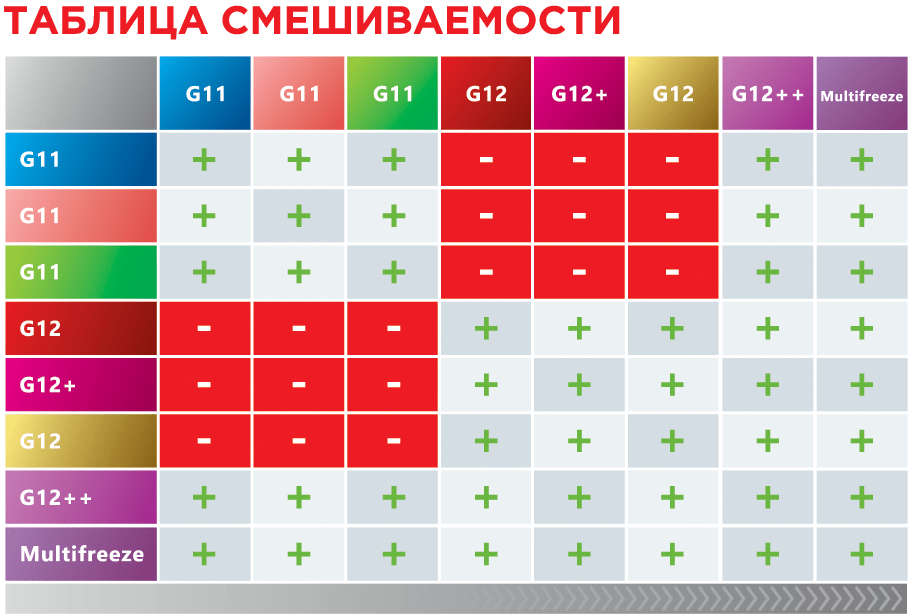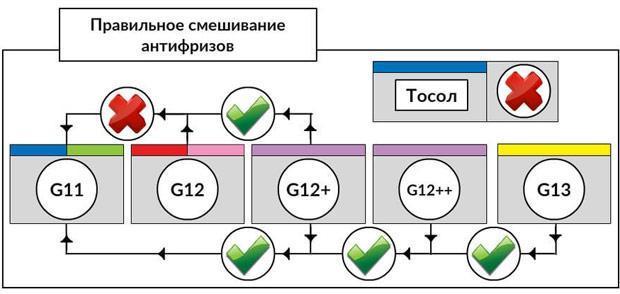
Can I mix G12 and G13 antifreeze?
Content
Antifreeze G12 and G13. What is the difference?
The vast majority of fluids intended for use in the cooling systems of modern cars consist of three components:
- basic dihydric alcohol (ethylene glycol or propylene glycol);
- distilled water;
- a package of additives (anti-corrosion, protective, antifoam, etc.).
Water and dihydric alcohol make up more than 85% of the total coolant volume. The remaining 15% is accounted for by additives.
Class G12 antifreezes, according to the established classification, have three subclasses: G12, G12 + and G12 ++. The base for all liquids of the G12 class is the same: ethylene glycol and distilled water. The differences lie in the additives.


G12 antifreeze has carboxylate (organic) additives. They work exclusively to prevent foci of corrosion and do not form a continuous protective film, as in coolant class G11 (or domestic antifreeze). G12 + and G12 ++ fluids are more versatile. They contain both organic and inorganic additives, capable of forming a protective film on the surfaces of the cooling system, but much thinner than in the case of coolant of the G11 class.
For G13 antifreeze, the base consists of propylene glycol and distilled water. That is, alcohol has been replaced, which ensures the resistance of the composition to freezing. Propylene glycol is much less toxic and less chemically aggressive than ethylene glycol. However, the cost of its production is several times higher than that of ethylene glycol. In terms of performance properties, regarding work in the car's coolant system, the difference between these alcohols is small. Additives in class G13 antifreezes are combined, similar in quality and quantity to G12 ++ coolants.


Can antifreeze G12 and G13 be interfered with?
There is no definite answer to the question of whether it is possible to mix G12 and G13 antifreezes. Much depends on the design of the cooling system and the mixing ratio of the liquids. Let's consider several cases of mixing G12 and G13 antifreezes.
- The system, in which the G12 antifreeze or any of its other subclasses is poured, is topped up to a significant extent (more than 20%) with G13 antifreeze. This mixing is acceptable but not recommended. When mixed, the base alcohols will not interact with each other. The liquid obtained by mixing G12 and G13 antifreezes will have a slight shift in the freezing point, but this will be a slight shift. But additives can conflict. Experiments of enthusiasts in this regard ended with different, unpredictable results. In some cases, the precipitate did not appear even after a long time and after heating. In other cases, when using different variations of fluids from different manufacturers, a noticeable turbidity appeared in the resulting mixture.


- Coolant of class G13 is added to the system designed for G20 antifreeze in a significant amount (more than 12% of the total volume). This cannot be done. In theory, systems designed for G13 antifreeze do not have to be made of materials with high protection against chemical attack, as was required for systems for G12 antifreeze. Propylene glycol has a low chemical attack. And if the car manufacturer took advantage of this opportunity and made any elements from unconventional materials, then aggressive ethylene glycol can quickly destroy elements that are unstable to its effects.
- A small amount of G12 antifreeze is added to the system that contains G13 antifreeze (or vice versa). This is not recommended, but it can be done when there is no other way out. There will be no critical consequences, and in any case, this is a more acceptable option than driving with a lack of coolant in the system.
You can completely replace G12 antifreeze with G13. But before that, it is better to flush the cooling system. Instead of G13, you cannot fill in G12.


Watch this video on YouTube
